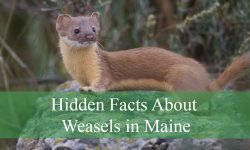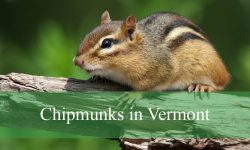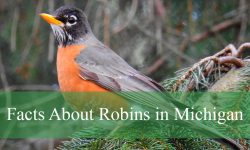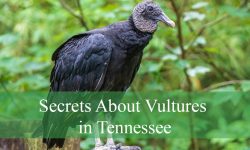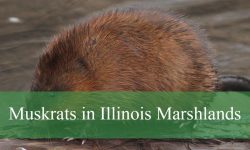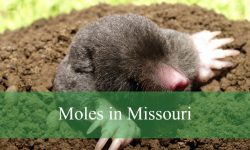Across Florida, you can encounter a variety of stinging insects, from docile honeybees to territorial hornets and fire ants. These insects play important roles in ecosystems but can pose risks to humans and pets.
Understanding how to identify and avoid dangerous stinging insects is essential for anyone spending time outdoors in Florida. Different species have unique behaviors, nesting habits, and venom potency, making awareness key to safety.
This guide covers 25 of the most dangerous stinging insects in Florida, including identification tips, behavior insights, habitat preferences, and precautions to help you stay safe while enjoying the outdoors.
Most Dangerous Stinging Insects Found in Florida
Eastern Yellowjacket (Vespula maculifrons)
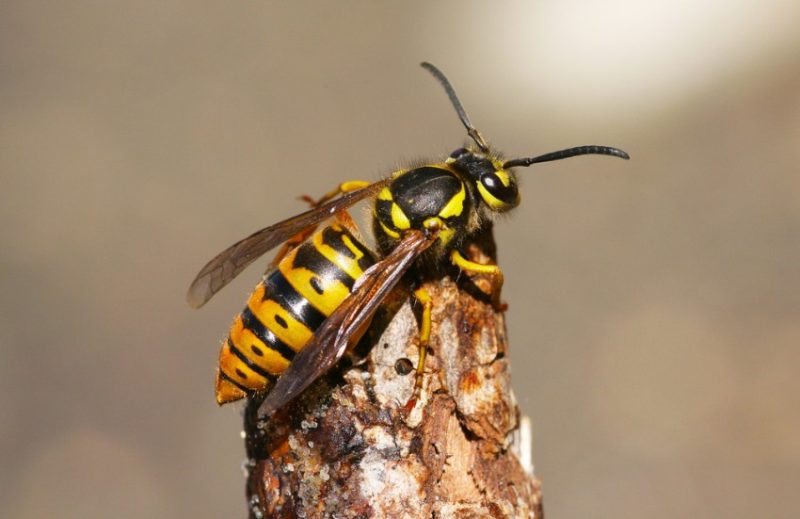
The Eastern Yellowjacket is a striking wasp with bright yellow and black bands across its abdomen. Its head is predominantly black with yellow markings around the eyes, making it easy to distinguish from honeybees. These wasps have a compact, robust body that allows agile flight and rapid movement.
Adult Eastern Yellowjackets range from 12–16 mm in length, with translucent wings and yellow legs. Their stinger is smooth, allowing them to sting multiple times. The bright coloration serves as a warning to potential predators.
Eastern Yellowjackets are aggressive foragers, often scavenging for sugary foods and proteins. They are social insects, living in large colonies with a queen and workers. They can become particularly defensive if their nest is disturbed.
They commonly build nests underground, often in abandoned rodent burrows, and occasionally in wall voids or attics. Their sting is painful and can trigger allergic reactions in sensitive individuals. Eastern Yellowjackets are widespread across Florida, especially in suburban and rural areas where food sources are abundant.
Southern Fire Ant (Solenopsis xyloni)
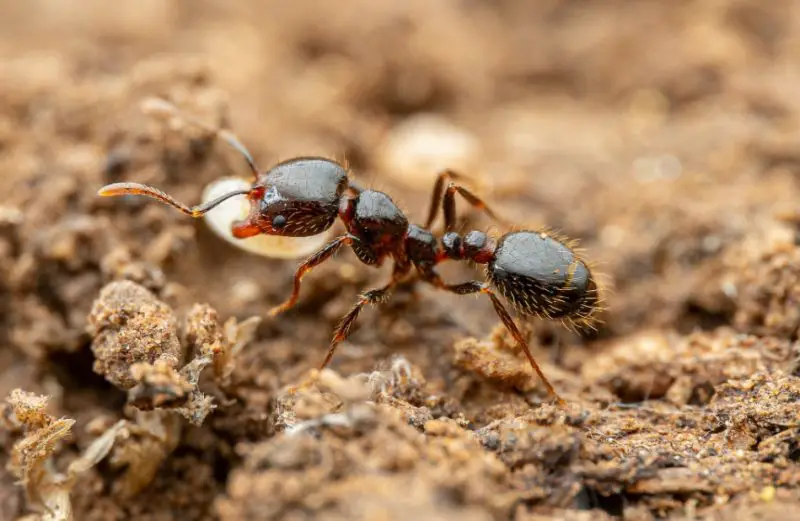
The Southern Fire Ant is a small but aggressive ant species with reddish-brown bodies and darker abdomens. They have a smooth, shiny exoskeleton and elbowed antennae, which help in detecting vibrations and chemical trails.
Workers are typically 3–6 mm long, while queens can reach 8 mm. Their mandibles are strong, used for biting, and their stingers inject venom that causes a burning sensation. These ants are capable of multiple stings, making them a threat to humans and pets.
Southern Fire Ants are highly territorial and build extensive underground colonies with multiple entrances. They actively forage for proteins and sugars, often forming large raiding groups to overpower prey. Their behavior is particularly aggressive when the nest is disturbed.
They are commonly found in sandy soils, open fields, lawns, and along roadsides throughout Florida. Their stings produce pustules and severe itching, and in rare cases, allergic reactions can occur.
European Honeybee (Apis mellifera)
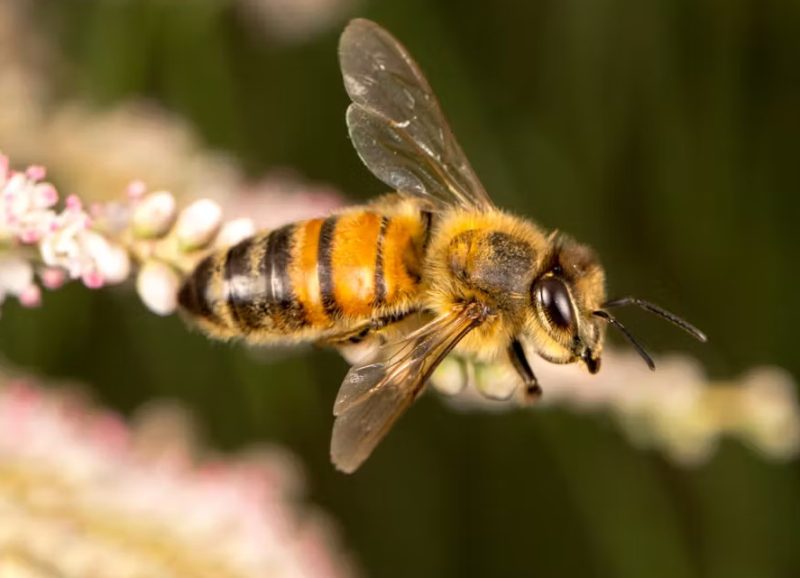
The European Honeybee is one of the most familiar stinging insects, recognized by its golden-brown body with black stripes and fine hair covering the thorax. Its body is slightly more elongated than wasps and has specialized structures for pollen collection.
Workers measure around 12–15 mm, while queens can reach 20 mm. Honeybees have barbed stingers, which means they can sting only once, leaving the stinger embedded in the skin. The venom contains proteins that cause pain and mild swelling.
Honeybees are highly social insects living in large hives with a strict caste system. They forage for nectar and pollen, playing a critical role in pollination. Despite being less aggressive than yellowjackets, they will defend their hive if threatened.
In Florida, European Honeybees thrive in gardens, orchards, and wildflower-rich areas. Stings can be painful and, for allergic individuals, potentially life-threatening, so caution is necessary when approaching hives.
Bald-Faced Hornet (Dolichovespula maculata)
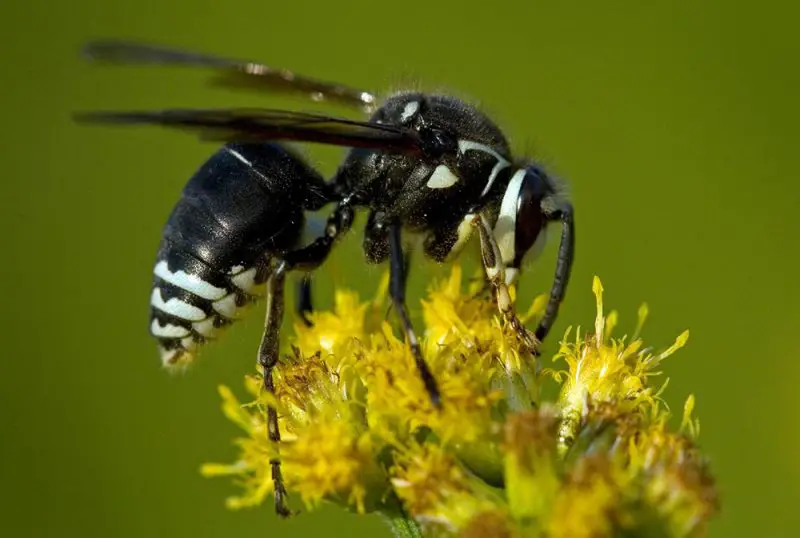
The Bald-Faced Hornet is a large wasp species with a black body marked by white or cream-colored facial and abdominal patterns. Its size and distinctive coloration make it easily recognizable from other wasps.
Adults are typically 19–25 mm in length, with long legs and a smooth stinger capable of delivering repeated painful stings. They have strong mandibles used for capturing prey and tearing plant fibers to build their large paper nests.
Bald-Faced Hornets are highly social, forming colonies that can exceed several hundred workers. They prey on insects, particularly flies and caterpillars, while also scavenging for sugary substances. Their defensive behavior is intense if their nest is disturbed.
They usually build large, gray, papery, football-shaped nests in trees or shrubs, often several feet above the ground. Their sting is extremely painful and can cause swelling, redness, and, in rare cases, severe allergic reactions.
Red Imported Fire Ant (Solenopsis invicta)
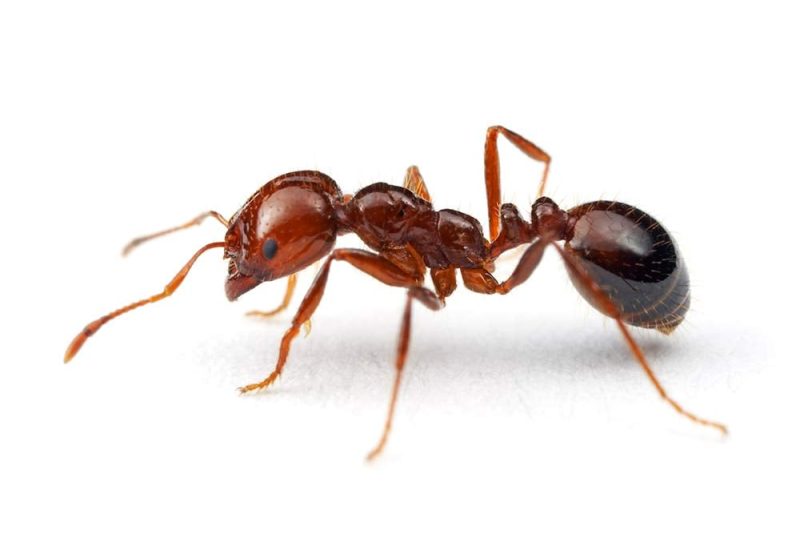
The Red Imported Fire Ant is notorious for its reddish-brown body with a darker abdomen. Its aggressive nature, painful sting, and ability to form large colonies make it a significant pest in Florida.
Workers range from 2–6 mm in length, while queens can reach up to 9 mm. Their stingers inject venom that causes a burning sensation and pustule formation. Multiple stings can occur if they perceive a threat.
These ants build large, mound-shaped nests in open areas such as lawns, fields, and pastures. They forage aggressively for food and defend their colonies vigorously. Their stinging behavior increases during hot months when they are most active.
Red Imported Fire Ants are highly adaptable and widespread across Florida, thriving in urban, suburban, and rural environments. Their stings can result in painful welts, allergic reactions, and, in extreme cases, anaphylaxis.
Paper Wasp (Polistes spp.)
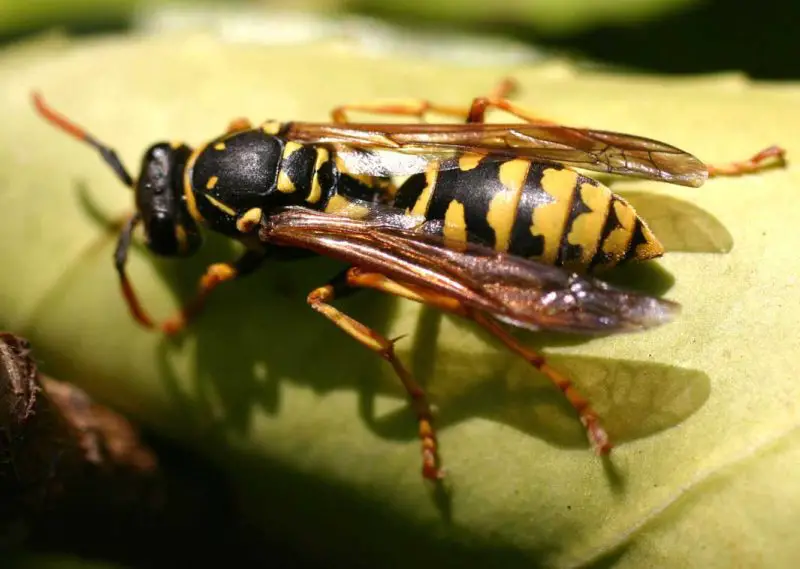
Paper Wasps are slender wasps with reddish-brown bodies marked by yellow or orange patterns. Their long legs hang below the body in flight, giving them a graceful appearance. Unlike yellowjackets, they have a more elongated and narrow abdomen.
Adults typically measure 15–25 mm in length. They have smooth stingers that can deliver multiple painful stings. Their mandibles are strong enough to grasp prey and manipulate nest materials.
Paper Wasps are social insects that build open, umbrella-shaped nests from paper-like fibers chewed from plant material. They forage for caterpillars and other soft-bodied insects to feed their larvae. Their behavior is generally non-aggressive, but they will sting to defend their nests.
They commonly nest under eaves, in shrubs, or under tree branches throughout Florida. Stings are painful and can cause localized swelling and itching. Allergic reactions, though rare, are possible in sensitive individuals.
Asian Giant Hornet (Vespa mandarinia)
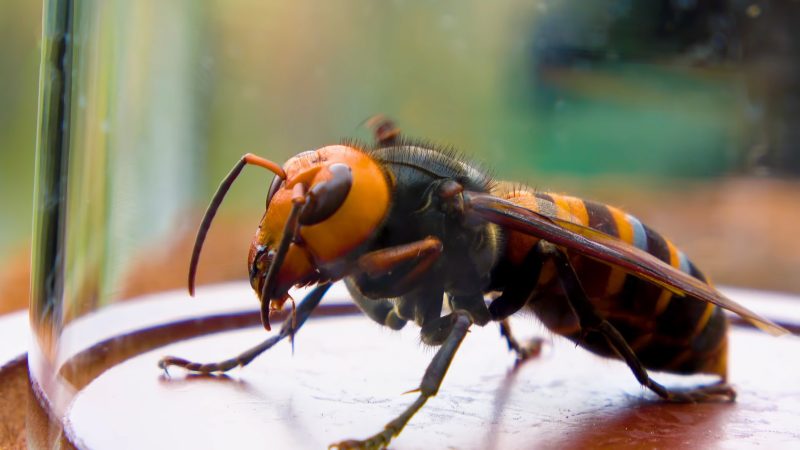
The Asian Giant Hornet is the largest hornet species in the world, with a striking yellow-orange head and dark brown thorax. Its eyes are large and dark, giving it excellent vision. While rare in Florida, occasional sightings have raised concern due to its potent venom.
Adults range from 30–50 mm in length with a wingspan of up to 75 mm. The stinger is long and powerful, capable of injecting large amounts of venom in a single sting. Their bite can also break skin, making them particularly dangerous.
Asian Giant Hornets are predatory, primarily feeding on other insects, including bees, and sometimes scavenging for sugary substances. They are highly defensive of their nests and can sting repeatedly if threatened.
Nests are usually built underground or in hollow logs in forested areas. The venom can cause extreme pain, tissue damage, and, in rare cases, life-threatening allergic reactions. Florida residents should remain cautious, even though sightings are uncommon.
Cicada Killer Wasp (Sphecius speciosus)
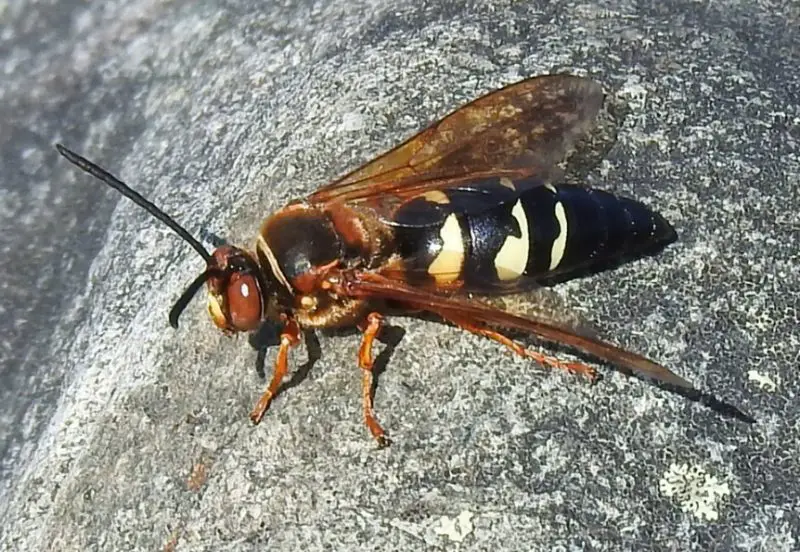
Cicada Killer Wasps are large solitary wasps with reddish-brown thoraxes, black and yellow striped abdomens, and long legs. Their intimidating size and rapid flight make them easily noticeable.
Adults range from 25–50 mm long. While their stinger is capable of piercing human skin, they are generally non-aggressive. Females use their stingers to paralyze cicadas, which they transport to underground burrows as food for their larvae.
Cicada Killer Wasps are solitary hunters and do not form colonies. Males are territorial and may hover around nesting sites, but they cannot sting. Their primary diet consists of nectar, while females focus on hunting cicadas.
They prefer sandy soils and open, sunny areas for burrowing, such as lawns, gardens, and fields across Florida. Although their size can be alarming, stings to humans are rare and usually occur only if the wasp is handled or provoked.
Velvet Ant (Mutillidae family)

Velvet Ants are not true ants but wingless female wasps. They are easily recognized by their bright red, orange, or yellow fuzzy bodies and black markings. Their dense hairs give them a velvety appearance, hence the name.
Females range from 10–25 mm, while males have wings and can fly. Their stinger is extremely potent and can deliver one of the most painful stings among insects. They are capable of stinging repeatedly, making them highly dangerous if handled.
Velvet Ants are solitary and do not form colonies. Females invade the nests of ground-nesting bees and wasps, laying eggs inside the host’s larvae. Adults feed primarily on nectar and are active in sunny areas.
They inhabit sandy or dry soils across Florida, often in fields, gardens, and open woods. Their sting causes intense pain, swelling, and localized redness, and caution is advised when outdoors in areas where they are present.
Yellowjackets (other Vespula spp.)
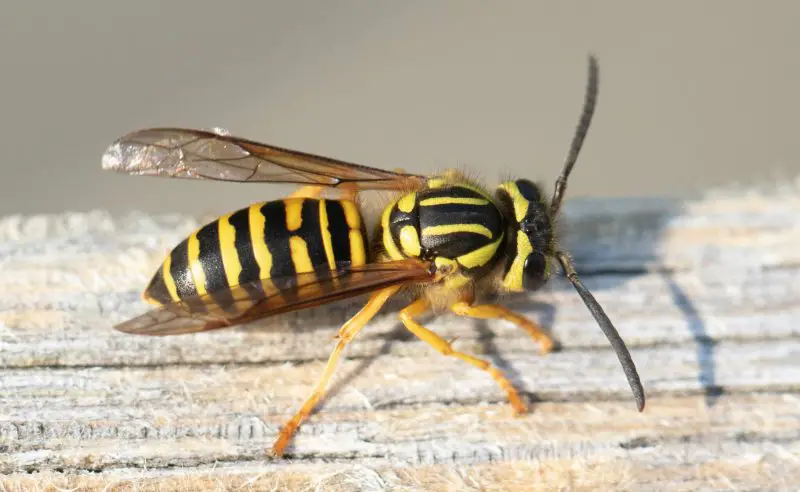
Yellowjackets are medium-sized social wasps with yellow and black banded abdomens. Other Vespula species resemble the Eastern Yellowjacket but may have subtle differences in coloration and body markings.
Workers measure 12–16 mm, while queens are slightly larger. Their smooth stingers can deliver multiple stings, injecting venom that causes burning pain and mild swelling. They are agile and fast fliers.
Yellowjackets live in large colonies, often building nests underground or in wall cavities. They are aggressive scavengers, attracted to sugary foods and proteins, and will defend their nests vigorously.
They are common throughout Florida, particularly in urban and suburban areas where food sources are available. Stings can be painful and, for allergic individuals, potentially dangerous, especially when multiple stings occur.
Sweat Bees (Halictidae family)
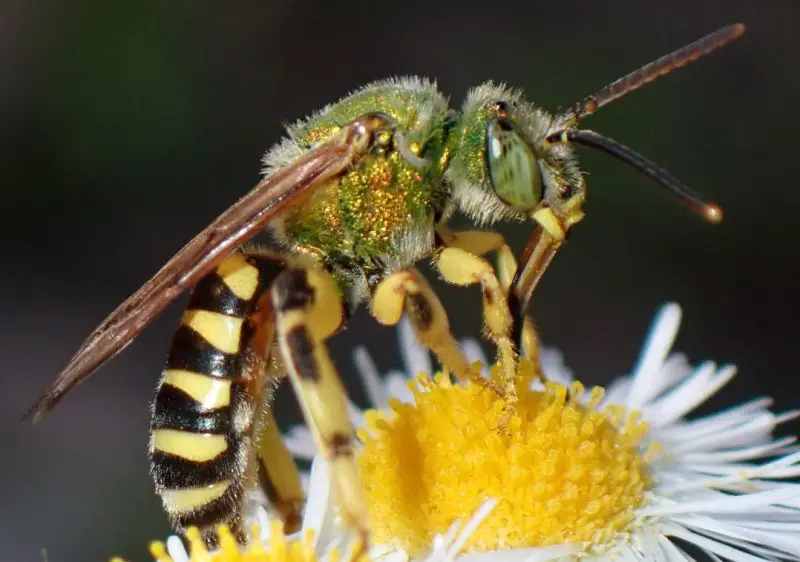
Sweat Bees are small, often metallic-colored bees, ranging from green to blue or bronze. They are named for their attraction to human sweat, which provides them with salts and moisture. Their compact size and metallic sheen make them noticeable in gardens and fields.
Adults typically measure 4–10 mm in length. While their stings are usually mild, they can sting repeatedly if provoked. Their stinger is small but sufficient to cause localized pain, redness, or itching.
Sweat Bees are mostly solitary or form small communal nests. They are important pollinators, visiting a wide range of flowers for nectar and pollen. Despite their generally non-aggressive nature, females may sting if trapped or handled.
They prefer sandy or loose soils for nesting and are commonly found in gardens, lawns, and meadows across Florida. Their stings are usually minor but can be more severe for allergic individuals.
Tarantula Hawk Wasp (Pepsis spp.)
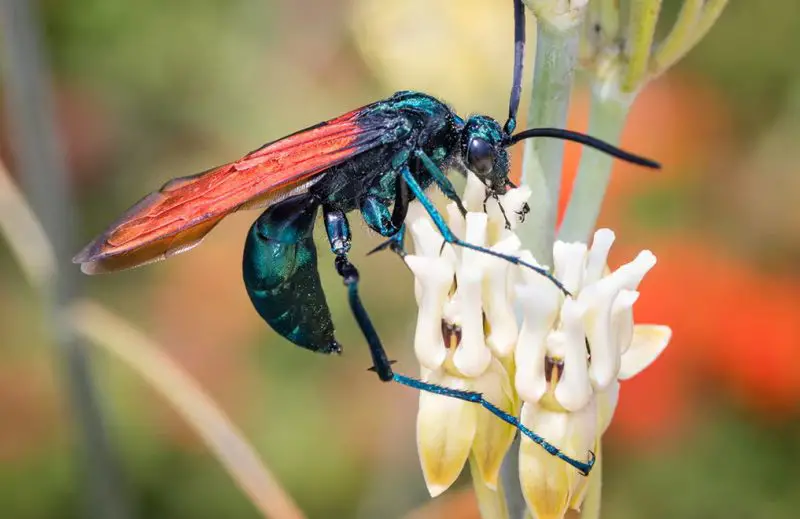
Tarantula Hawk Wasps are among the largest wasps in Florida, with striking black bodies and vivid orange or reddish wings. Their size and coloration make them highly noticeable and intimidating to predators.
Adults measure 35–50 mm in length, and their stinger is one of the most painful in the insect world. Although the sting is excruciating, it is rarely dangerous to humans and usually lasts only a few minutes.
These wasps are solitary hunters. Females paralyze tarantulas using their powerful sting, drag them into underground burrows, and lay a single egg on the spider. The larva feeds on the immobilized tarantula until it matures.
They inhabit open areas, deserts, and sandy soils in Florida, often near tarantula burrows. Their large size and distinctive flight patterns make them easy to spot. Despite their fearsome reputation, they are not aggressive unless directly provoked.
Carpenter Bee (Xylocopa virginica)
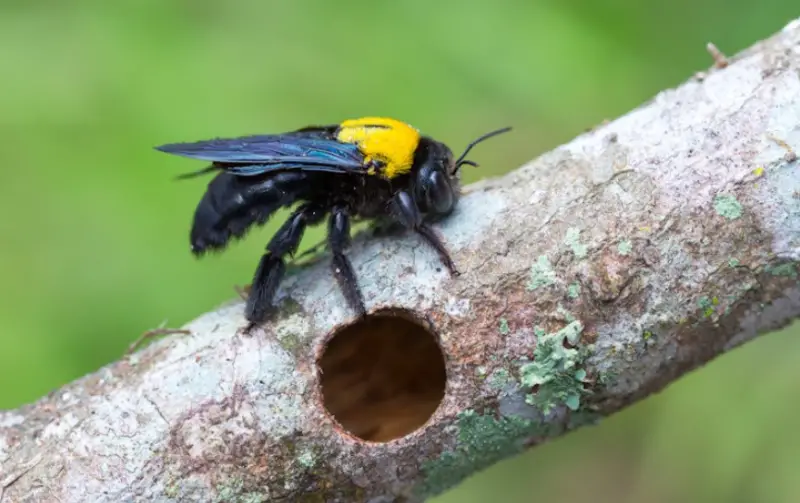
Carpenter Bees are large, robust bees with shiny black abdomens and yellow faces. Males are often more colorful and can hover in the air, while females are primarily black. They are solitary bees that bore into wood to build nests.
Adults range from 15–25 mm in length. Females possess a powerful stinger capable of multiple stings, while males are harmless since they lack stingers. Stings can cause localized pain, swelling, and redness.
Carpenter Bees excavate tunnels in wooden structures, tree trunks, or fence posts to lay eggs. They feed on nectar and are important pollinators, visiting flowers for pollen and nectar throughout Florida.
They are widespread across Florida, particularly in gardens, parks, and areas with exposed wood. Their stings are painful if handled, but they generally avoid humans unless provoked.
Horse Guard Wasp (Stictia spp.)
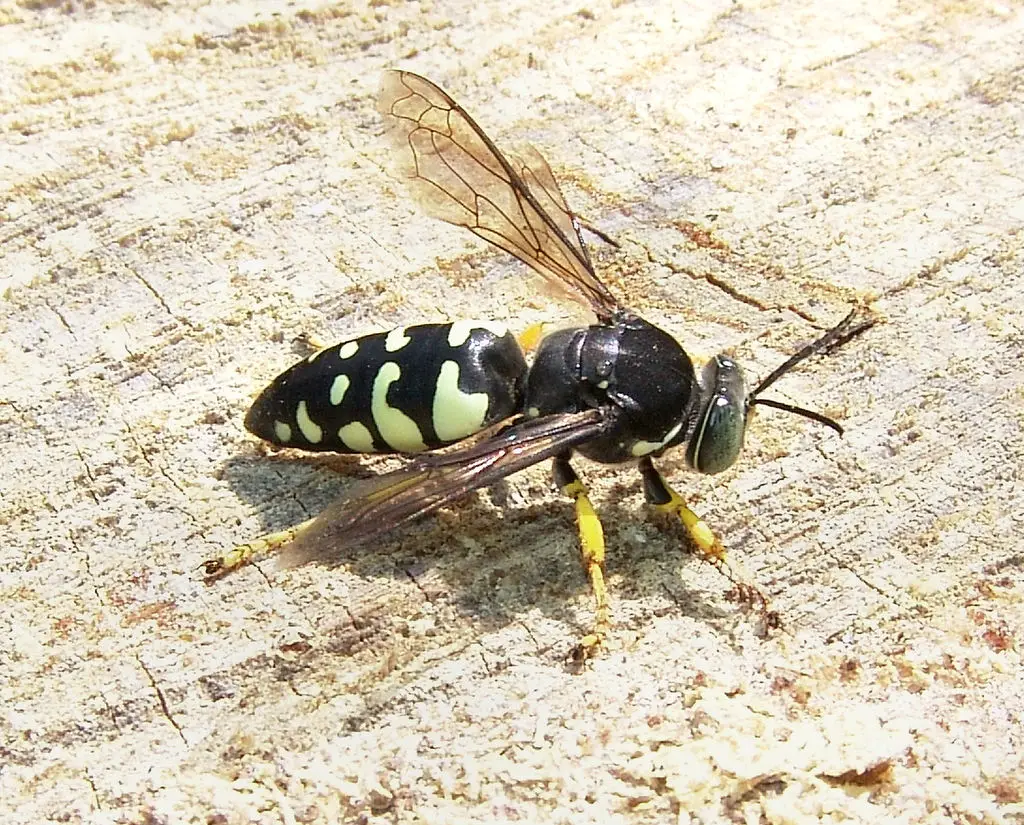
Horse Guard Wasps are medium-sized solitary wasps with slender bodies marked by black and yellow or orange patterns. They are named for their tendency to patrol pastures and open areas, guarding against pest insects.
Adults measure 15–25 mm in length. Their stingers are capable of delivering painful stings, though they are rarely dangerous unless handled or provoked. They use their stingers primarily to subdue prey.
These wasps hunt horse-flies and other small insects, paralyzing them to feed their larvae. They dig burrows in sandy soils where the immobilized prey is stored for developing offspring.
Horse Guard Wasps are found in pastures, fields, and open sandy areas throughout Florida. While they are aggressive hunters toward other insects, they generally avoid humans, and stings are uncommon.
Digger Wasp (Sphex spp.)
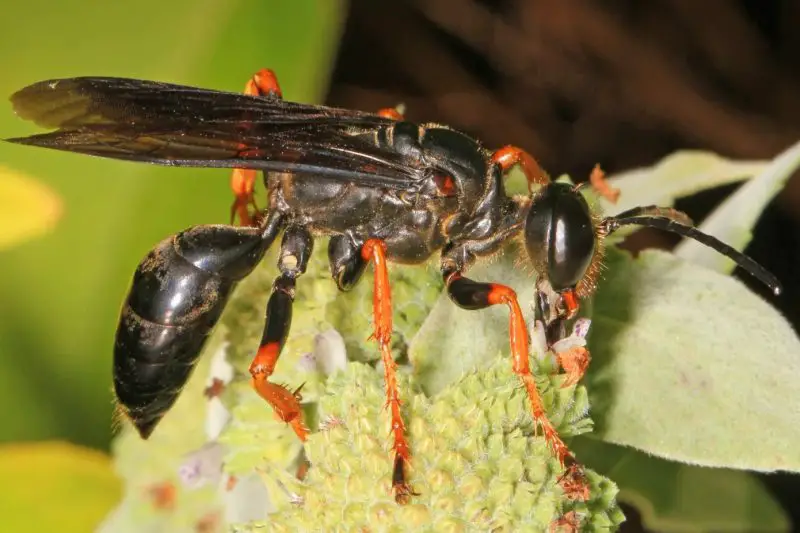
Digger Wasps are medium to large solitary wasps with black or metallic-colored bodies and orange or yellow markings. They have long legs and a distinctive elongated abdomen used for maneuvering in burrows.
Adults range from 15–35 mm in length. Their stingers are potent and used to paralyze prey. They can sting humans if handled, causing sharp pain and localized swelling.
Digger Wasps dig burrows in sandy soils and provision them with immobilized insects, such as grasshoppers or crickets, for their larvae. Adults feed on nectar and are important pollinators.
They inhabit sandy areas, gardens, and open fields across Florida. Though their size and stings can be intimidating, they are generally non-aggressive toward humans unless provoked.
Mud Dauber Wasp (Sceliphron spp.)
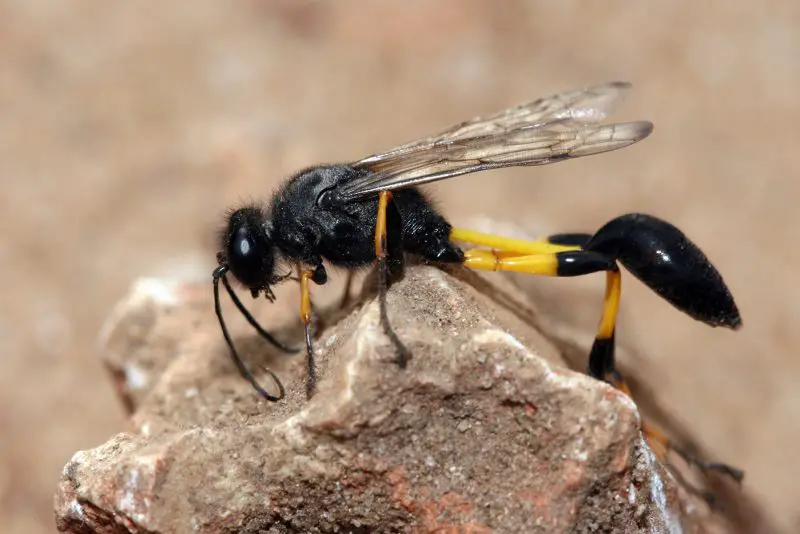
Mud Dauber Wasps are slender wasps with elongated bodies, usually black or metallic blue with yellow markings. Their narrow waist and long legs make them distinctive in flight. They are solitary and build mud nests in sheltered locations.
Adults measure 15–25 mm in length. Females possess smooth stingers capable of multiple stings, but they are rarely aggressive toward humans. Stings can cause mild pain and localized swelling.
These wasps hunt spiders, which they paralyze and place inside mud nests as food for their developing larvae. They feed on nectar as adults and are active during warm months.
Mud Dauber nests are commonly found under eaves, in garages, or on walls throughout Florida. While their sting is not highly dangerous, caution is advised when handling or disturbing them.
Wool Carder Bee (Anthidium manicatum)
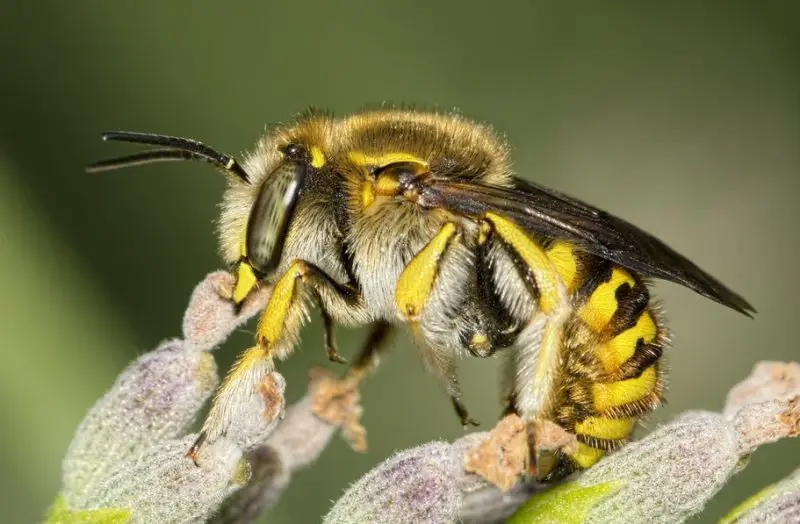
Wool Carder Bees are medium-sized solitary bees with black bodies covered in yellow markings and dense hairs. They get their name from collecting plant fibers (“wool”) to line their nests.
Adults range from 12–18 mm in length. Females have stingers capable of multiple stings, causing localized pain, while males are territorial but cannot sting. Their bite can be painful if they grab the skin with mandibles.
These bees collect plant hairs from leaves to construct individual brood cells and feed primarily on nectar. They are highly territorial, often chasing away other insects from their feeding area.
Wool Carder Bees are commonly found in gardens, meadows, and areas with flowering plants across Florida. Though their stings are painful, they are not considered highly dangerous to humans.
European Hornet (Vespa crabro)
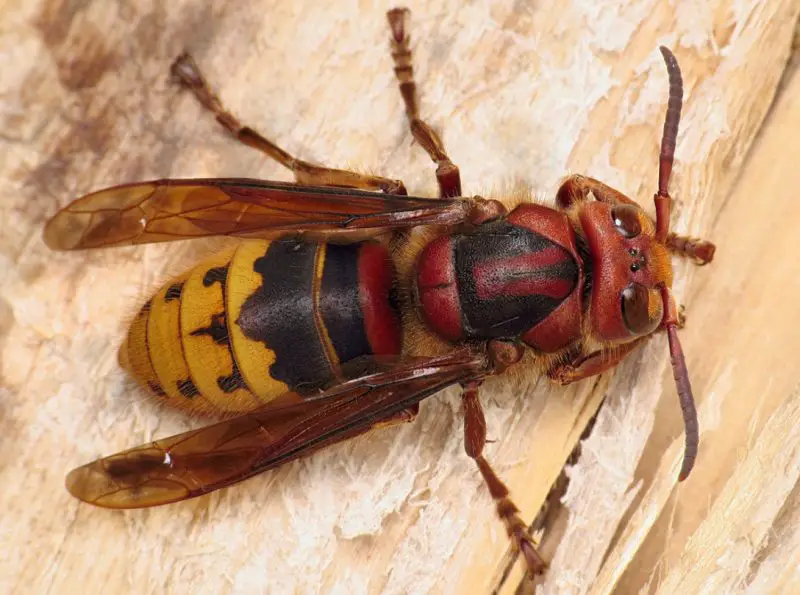
European Hornets are large wasps with reddish-brown thoraxes, yellow and brown banded abdomens, and large mandibles. They are the largest social wasps in Florida and can be intimidating due to their size.
Adults measure 25–35 mm in length. Their smooth stinger delivers multiple painful stings, and the venom can cause redness, swelling, and allergic reactions in sensitive individuals.
European Hornets live in colonies, building large paper nests inside hollow trees, wall voids, or attics. They hunt insects such as flies and caterpillars while also feeding on sugary substances.
These hornets are found across Florida, particularly in wooded areas and suburban neighborhoods with suitable nesting sites. Their stings are highly painful, but they usually sting only when provoked.
Giant Resin Bee (Megachile sculpturalis)
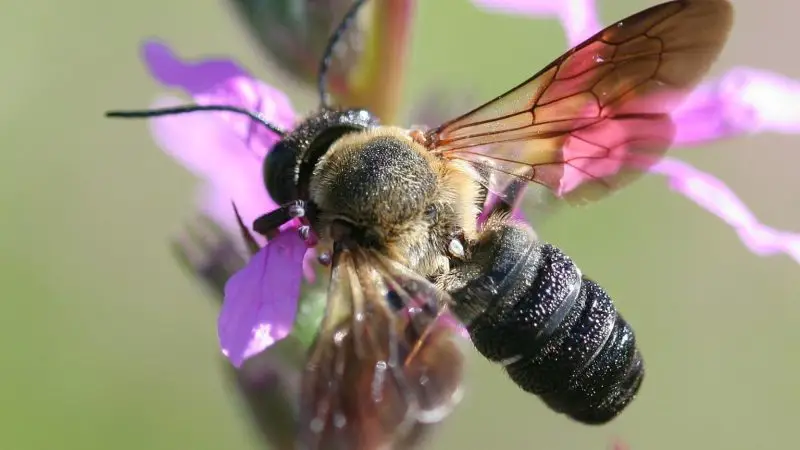
Giant Resin Bees are large solitary bees with black or dark brown bodies and robust mandibles. They are named for their habit of using resin to construct and seal brood cells.
Adults range from 20–25 mm in length. Females have stingers capable of delivering moderate pain, while males are harmless. Their stings are rarely serious but can cause swelling and redness.
These bees nest in hollow plant stems, wood cavities, or man-made structures, collecting resin and leaves to line their nests. Adults feed on nectar and are effective pollinators.
Giant Resin Bees are increasingly common in gardens, orchards, and urban areas of Florida. They are generally non-aggressive and sting only when handled or threatened.
Thread-waisted Wasp (Ammophila spp.)
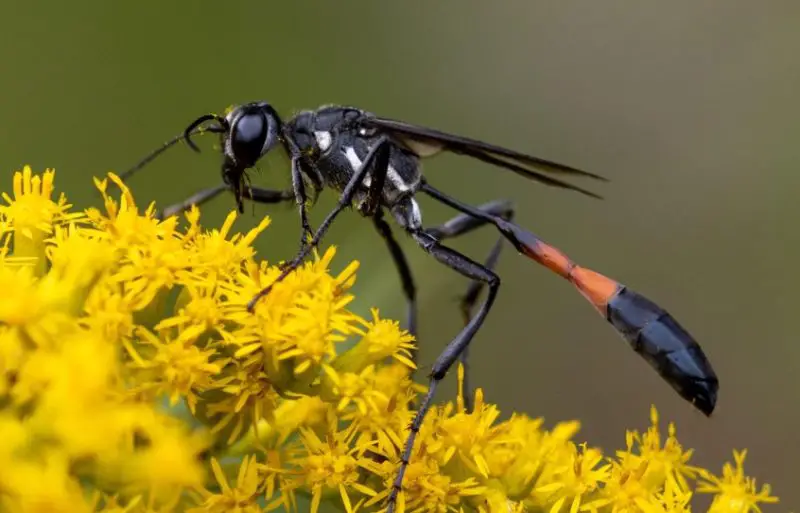
Thread-waisted Wasps are slender, elongated wasps with thin “thread-like” waists connecting the thorax and abdomen. They are typically black or dark brown with orange or yellow markings.
Adults measure 15–25 mm in length. Females possess smooth stingers capable of multiple stings, but they are rarely aggressive toward humans. Stings can cause sharp pain and localized swelling.
These solitary wasps dig burrows in sandy soils and provision them with paralyzed insects, often caterpillars, for their larvae. Adults feed on nectar and are important pollinators.
Thread-waisted Wasps are found in gardens, fields, and open sandy areas across Florida. Though their appearance and stings can be intimidating, they generally avoid humans unless provoked.
Cicada Hunter (Palmodes spp.)
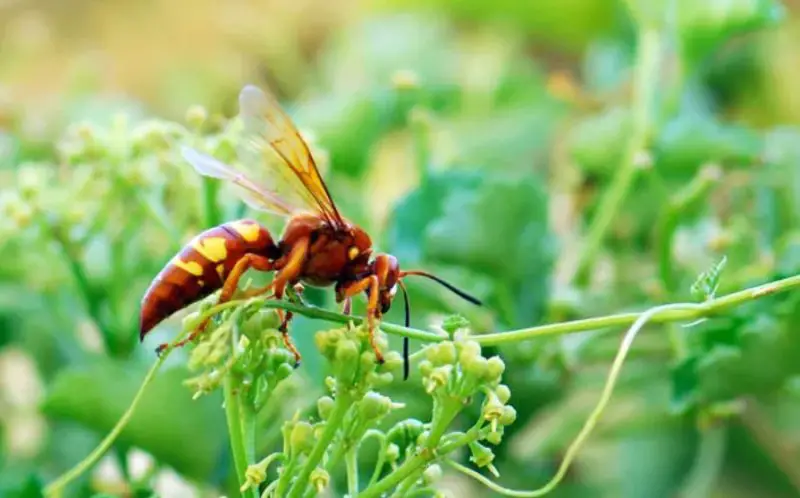
Cicada Hunters are solitary wasps with slender bodies, typically black with yellow or orange markings. They are recognized by their powerful flight and long legs, which assist in capturing prey.
Adults range from 20–35 mm in length. Females have stingers used to paralyze cicadas, and while capable of stinging humans, they rarely do so unless provoked. Stings can cause sharp pain and localized swelling.
These wasps hunt cicadas, dragging the paralyzed insects into underground burrows where they lay eggs. Their larvae feed on the immobilized cicadas, while adults feed primarily on nectar.
Cicada Hunters prefer sandy soils and open areas such as lawns, fields, and woodland edges across Florida. Despite their intimidating size, they are generally non-aggressive toward humans.
Sand Wasp (Bembix spp.)
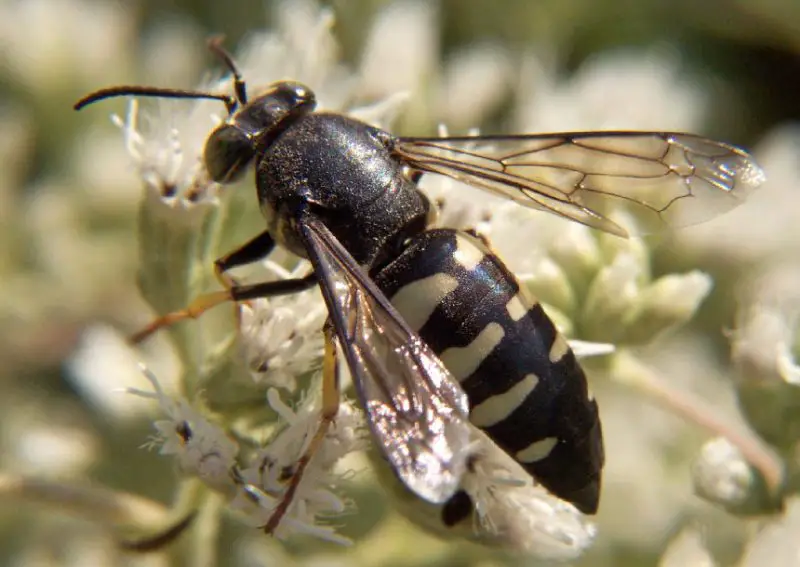
Sand Wasps are solitary, ground-nesting wasps with black, yellow, or white banded bodies. They have slender waists and long legs, which make them agile hunters of small insects.
Adults measure 12–25 mm in length. Females possess stingers used to paralyze prey for their larvae. Stings to humans are rare but can cause sharp pain if handled.
Sand Wasps dig burrows in sandy soils, provisioning each burrow with immobilized insects, often flies, for their developing larvae. Adults feed on nectar and pollen.
They are commonly found in sunny, sandy areas throughout Florida, such as beaches, dunes, and open fields. While their sting is painful, they avoid humans unless disturbed.
Blue Mud Dauber (Chalybion spp.)
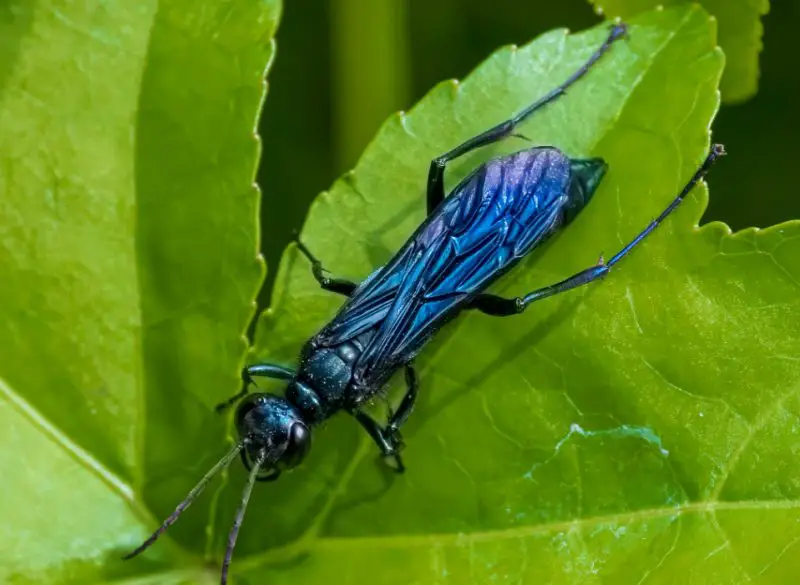
Blue Mud Daubers are solitary wasps with metallic blue-black bodies and slender waists. Their long legs and narrow profile make them agile flyers, and their iridescent coloration is distinctive.
Adults range from 15–25 mm in length. Females can sting, but they are rarely aggressive toward humans. Stings may cause mild pain and localized redness.
These wasps capture spiders, paralyzing them to provision mud nests for their larvae. They feed on nectar as adults and are active during warm months.
Blue Mud Daubers often nest under eaves, in sheds, garages, or other sheltered locations across Florida. They are non-aggressive and usually sting only when directly threatened.
Long-horned Bee (Melissodes spp.)
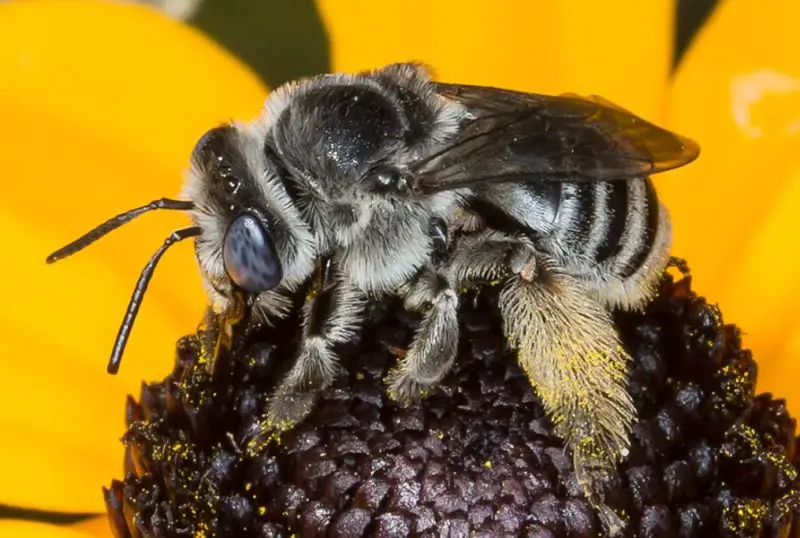
Long-horned Bees are solitary bees with elongated antennae, especially in males, and hairy bodies ranging from black to brown. They are important pollinators of native plants and crops.
Adults typically measure 10–18 mm in length. Females have stingers and can deliver mild to moderate pain if provoked. Males are harmless but may defend territory around flowers.
These bees nest in the ground, often in sandy soils, and feed primarily on nectar and pollen. They are generally non-aggressive toward humans.
Long-horned Bees are widespread across Florida, particularly in gardens, meadows, and fields. While they can sting, incidents are rare and usually minor.
Assassin Wasp (Pompilidae family)
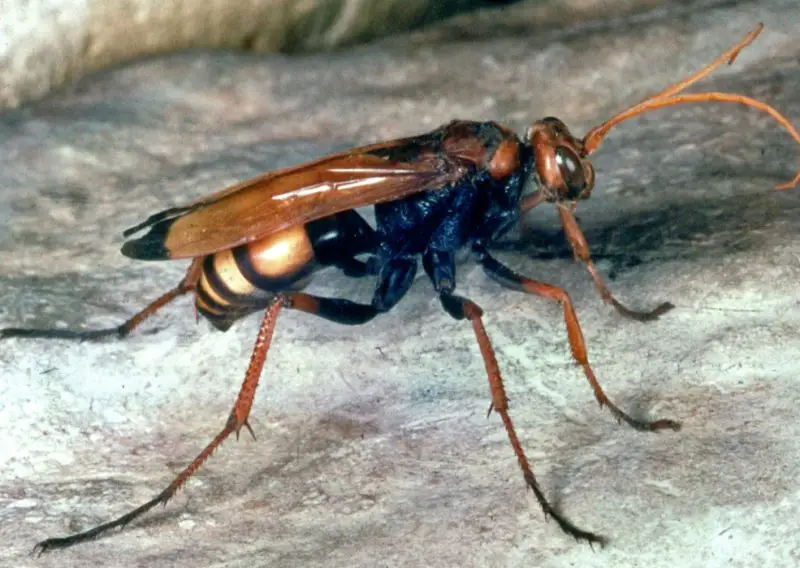
Assassin Wasps are solitary wasps, often black or dark-colored, with slender bodies and long legs. They are known for hunting spiders and immobilizing them to feed their larvae.
Adults range from 15–35 mm in length. Females have stingers capable of delivering painful stings if handled, but they rarely sting defensively.
These wasps paralyze spiders, dragging them into underground burrows or concealed nests for their larvae. Adults feed on nectar and sometimes honeydew from plants.
Assassin Wasps are found in sandy soils, gardens, fields, and woodland edges throughout Florida. They are not aggressive toward humans and generally sting only when provoked.
FAQs About Dangerous Stinging Insects in Florida
What are the most common stinging insects in Florida?
The most common stinging insects in Florida include yellowjackets, Eastern Yellowjackets, European Honeybees, Bald-Faced Hornets, and Red Imported Fire Ants. Other frequently encountered species are Paper Wasps, Sweat Bees, and Carpenter Bees. These insects are found in urban, suburban, and rural areas across the state.
How can I identify stinging insects?
Stinging insects can be identified by their size, color patterns, body shape, and behavior. For example, yellowjackets are yellow and black with a compact body, while Bald-Faced Hornets are larger with black and white markings. Sweat Bees are smaller with metallic coloring, and Mud Daubers are slender and often blue or black. Observing their nests and flight patterns also helps in identification.
Are all stings dangerous?
Not all stings are equally dangerous. Most stings from bees and wasps cause temporary pain, redness, and swelling. However, stings from species like Red Imported Fire Ants, Bald-Faced Hornets, or Tarantula Hawk Wasps can be extremely painful. Allergic individuals may experience severe reactions such as anaphylaxis, which requires immediate medical attention.
Where do stinging insects usually live?
Stinging insects inhabit a wide variety of environments. Many build nests underground (yellowjackets, fire ants), in trees or shrubs (Bald-Faced Hornets, Paper Wasps), or in man-made structures like eaves, attics, and wooden fences (Carpenter Bees, European Hornets). Solitary species like Mud Daubers, Cicada Killers, and Assassin Wasps often dig burrows in sandy soils.
How can I prevent stings?
To prevent stings, avoid disturbing nests, wear protective clothing when outdoors, and keep food and sugary drinks covered. Be cautious when working in gardens, lawns, or areas with exposed soil. For aggressive species like fire ants, professional pest control may be necessary.
What should I do if stung?
For most stings, wash the area with soap and water, apply a cold compress, and take an over-the-counter pain reliever or antihistamine. Monitor for signs of severe allergic reactions, such as difficulty breathing, swelling of the face or throat, dizziness, or rapid heartbeat. Seek immediate medical attention if these symptoms occur.
When are stinging insects most active?
Stinging insects are most active during the warmer months, typically spring through early fall. They are particularly active in Florida’s hot and humid environment. Daytime hours, especially late morning to early afternoon, are when foraging and nest defense behaviors peak.
Can stinging insects sting multiple times?
Some insects, like wasps and yellowjackets, have smooth stingers and can sting multiple times. Honeybees have barbed stingers, so they can sting only once, often dying afterward. Solitary wasps like Mud Daubers and Tarantula Hawks can sting multiple times but are rarely aggressive toward humans.

